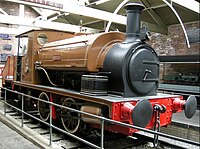Bradford Industrial Museum
[2] It was bought by Clifford and Arnold Wilson in 1908 who installed a mill engine built by Cole, Marchent and Morley in 1910.
[4] Most of the space is taken up with several examples of cars and light commercial vans built by the Jowett company of Bradford, Scott motorbikes and Baines bicycles.
[4] Nellie is an 0-4-0 saddle tank industrial locomotive 1435, one of two built by Hudswell Clarke in Leeds in 1922 for the Esholt sewage works.
It is operated by compressed air and produces a wide paper tape that contains perforations that when transferred to the caster give full instructions for each character to be cast.
[6] There is a "forme" (text lines produced on a Linotype typesetting machine) made up into the front page of the last edition of the Yorkshire Sports, 2 May 1981.
The slivers of wool or hair are fed into the machine, through rollers, and onto the pins of the fallers which disentangle and transport the fibres to the nip jaw.
[6] The machines, known as boxes, in the drawing section, reduce the combed tops from thick slivers to thinner roving ready for spinning.
This process takes place in a series of gill boxes in which the fibres are redistributed, the slivers made uniform in thickness, and moisture added in order to give the wool its natural suppleness and condition.
There are three types of spinning machines or frames in common use in the United Kingdom, namely flyer, cap and ring.
All three types of machine or frame are similar in their method of drawing out or drafting the roving to make the required count or thickness but differ in the way in which twist is imparted and the yarn wound onto the bobbin.
It is suitable for producing thick smooth yarns from coarse quality wools and hairs, but is falling into disuse because of the low speed at which the spindles have to run.
[6] The introduction of the cap frame c.1828 was a step forward in attaining higher production and finer yarn spinning.
The passage of the yarn from the front rollers to the paper tube – used in place of a bobbin – is different from other types of spinning frames.
When the yarn leaves the rollers it passes direct to the top of an elongated spindle and coils around it two or three times before forming a balloon to the ring traveller.
This enables the twist to be imparted between the spindle top and roller nip, thus helping to produce a smoother yarn.
[6] The era of Industrial Revolution weaving machinery gave rise to technological jargon in places such as Yorkshire with a strong local dialect.
The resultant inscrutability of linguistic terms has given rise to such jokes as the one from Monty Python's Trouble at Mill sketch: One on't cross beams gone owt askew on treadle.
[18] In big factories, power could be transferred from one large drive wheel to another across a wide room via a reciprocating beam, called in that situation a crossbeam.
Whether a foot-driven treadle could power a mighty crossbeam is a moot point, and may be a joke in itself, but the explanation of the above phrase and its humour is tightly connected with the mechanism of the weaving machinery described below.
Many of the designs for woven fabrics made today were developed and created long ago on similar narrow-width pattern looms.
It was introduced c.1900 and the makers claimed that a speed of 160 picks per minute could be easily attained with from 2 to 8 shafts weaving a variety of fabrics.
The loom has four rising or drop boxes at each side, which can be moved independently and can weave up to seven shuttles, each with a different colour.
The word "selvedge" is derived from self-edge, the edge of the cloth where the weft is turned back as it returns through the shed.
On the left side of the loom is the patent four-shuttle drop box motion incorporating a foot pedal.
[4] Among other exhibits there is a heavy-duty British Railways dray, a decorative chaff cutter, and a horse fodder measure.
It was successful enough for the manufacturers to export it worldwide – for example to the Warsaw Fire Guard – but it was expensive in coal and horses, and was superseded by motor pumps in c.1900.
[20] There are living history events, family activity days, and a yearly Victorian-style Christmas craft market.
[4] In 1973 the museum held the first solo exhibition of the work of Edna Lumb, noted for her depiction of industrial life, especially equipment such as engines, pylons, quarries, and wheels.
Organised Freemasonry began with the formation of the Grand Lodge of England in 1717 and a social fraternity grew out of operative Masonic guilds.
One of the exhibition's centrepieces was a sumptuous robe worn by Sarastro in The Royal Opera House London's production of Mozart's The Magic Flute.
















